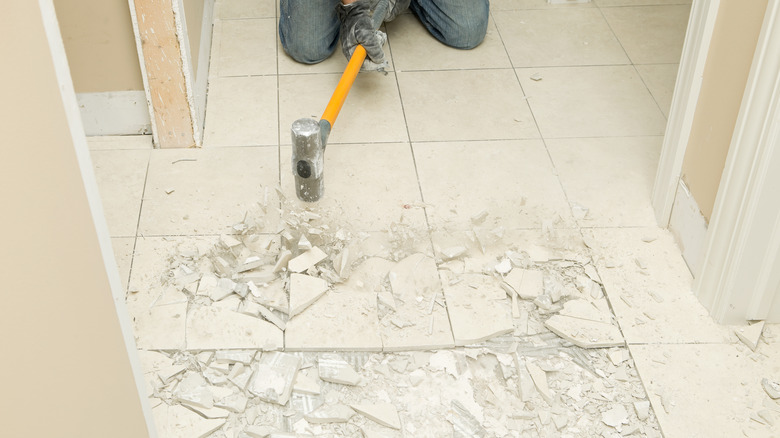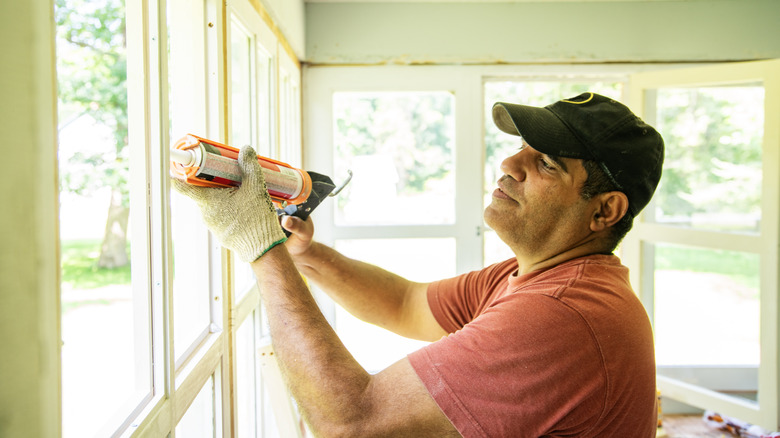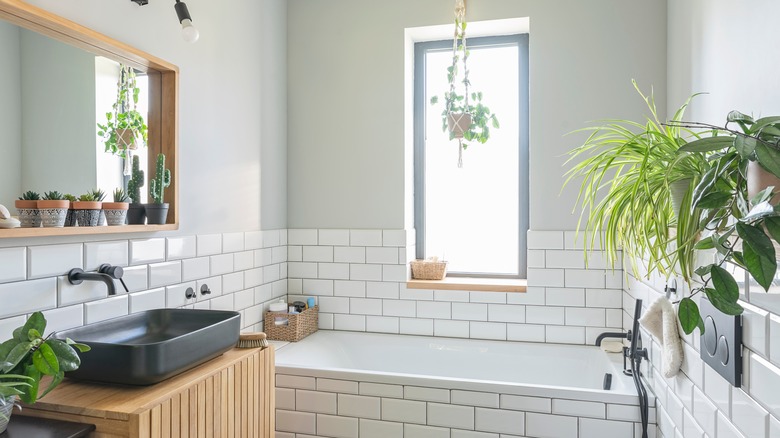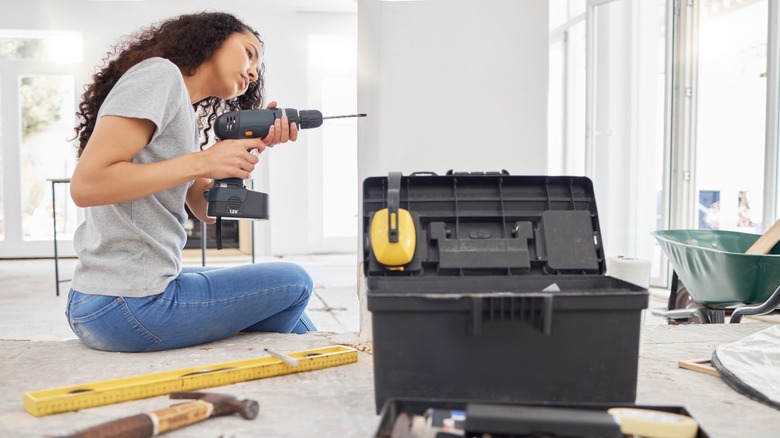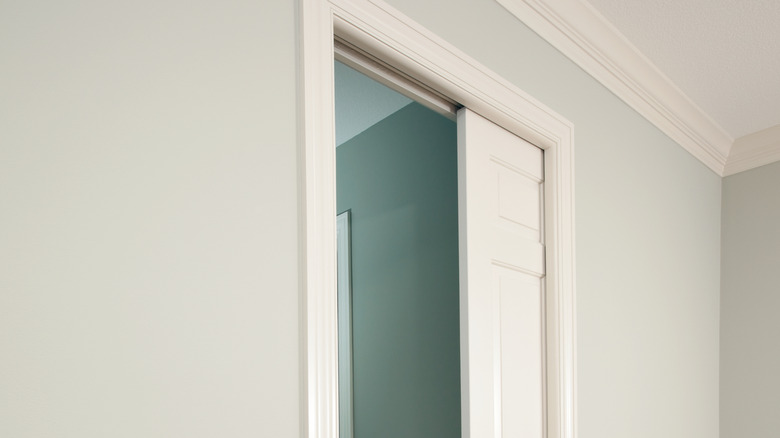Mike Holmes' Best Tips & Tricks For A Seamless Home Renovation
We may receive a commission on purchases made from links.
Mike Holmes knows a thing or two about how to renovate a home. The Canadian contractor has been the darling of HGTV for years, starring in many shows operating on the premise of cleaning up the messes of workers who didn't know what they were doing (or just didn't care). While he isn't filming, Holmes dedicates most of his time to teaching others how to do things right (the first time).
He knows the best way to build a fence, what to ask before hiring a contractor, and the things not to do if you don't want to double-dip and overdo your budget. Whether you want to DIY your entire home renovation or be sure to hire a contractor who won't completely mess up the job, these are Mike Holmes' best tips and tricks for a seamless home renovation.
Spend more time planning than renovating
A successful home renovation starts long before demo day begins. Holmes thinks the best way to ensure things go smoothly is to do plenty of research and make extensive plans before you even hire a contractor. "Slow down, take your time. Don't be in a hurry to get on my show," he told Halton Hills Today. "You can't run just because you decided to do a new kitchen or bathroom, or basement. You still need to know things like, 'Can we take this wall down? What can we do financially?'" Holmes insists that anyone who rushes into a renovation is more likely to encounter bigger problems down the road.
As far as a suggested timeline for the planning phase, the HGTV star is honest that it needs to be a lot longer than you might think. "It's going to take you more time to set up the job than it is to do the job, so know that going in," he continued. "Take your time, educate yourself, and check out your contractor." If you aren't sure where to start, money is usually the best variable. Be realistic about how much you can spend and what you want it to accomplish. For example, the best way to plan a kitchen renovation budget is to set aside about 10% of your home's total value for the project.
Pad your budget for both essentials and unexpected problems
While you are in the planning phase and deciding your budget, Holmes argues that two things can be true at the same time. You need to be conservative in your spending and never stretch yourself too thin, but cheaping out on essential items will still likely cost you more over time. "Be realistic about what you can afford to spend, but don't be afraid of the price tag," he wrote in an HGTV article. "Choosing to spend more money on certain materials can give you a home that will last longer, saving you money in the long run."
That said, you can't allocate every single dollar at the beginning of your project. Instead, you still need to leave a sizable amount of padding in the budget. If he's learned anything in his years of experience, it's to "always expect the unexpected." It's happened to clients, and Holmes as well. "When refinishing my basement, we discovered significant cracks in the foundation that could not be ignored," he continued. "So make sure you give yourself a buffer for any unexpected and costly surprises that might be revealed during your renovation."
You don't need to hire every renovation professional separately
While you're in the planning stages of your renovation, you might feel stuck when trying to hire the right people. However, one of Mike Holmes' favorite ways around this issue is focusing your research on just one general contractor instead of trying to assemble a team on your own. "Think about it: most people will hire a professional kitchen cabinet company to install their cabinetry, but what about electrical? What about plumbing? What about the flooring?" he asked viewers on the Marc + Mandy show, explaining that it's easy to get overwhelmed by the prospects.
Yet, instead of freaking out, he thinks you should simply narrow your search. "Particularly if you're planning on making structural changes to the home, such as taking a wall down, you really need to talk to a general contractor, who likely has relationships with a plumber, electrician, and a kitchen company," Holmes continued. There is no need to reinvent the wheel. This is especially true if you trust your general contractor's judgment (which you should if you hire them). It just makes sense to go with their guy.
Pull up old tile before installing a new layer
If you are carpeting a home, you are typically able to lay it and the padding needed under it straight over the top of any existing flooring, be it hardwood, concrete, etc. However, if you are installing any new tile, Holmes has a tip to make sure everything goes smoothly. "Some homeowners and contractors think you can lay your new tile directly over your existing tile to save some time," he said in an Instagram Reel. "Why do I hate this? Well, for one thing, you're just asking for your new tile and grout to crack — so that brand new floor isn't going to keep its look for very long."
This major flooring mistake is caused by the weight of the stacked tile. The rigid materials don't have anywhere to go, and the pressure becomes too great. "If your home was built to minimum code, it's not built to carry that much weight," he continued. Instead, when swapping out tiling, be sure to do the extra work for pulling out the old tile so you can have a look at the subflooring for any issues. Once you're sure nothing is rotten, moldy, or warped, Holmes says you can lay the new tile without issue.
You should paint room features in a specific order
Many homeowners choose to paint the interior of their homes themselves to save money. However, if you decide to skip the professionals, Holmes recommends you do your interior painting in a certain order to get professional results. "Start with the baseboards and trim, then do the ceiling, then do the walls last," he wrote on his website, Make It Right. He advises that starting small means that you are less likely to run out of steam during the project, as you've taken care of the finicky details first. Plus, if you paint the ceiling before the walls, you don't have to worry about any splatters that drip down, as you can just cover them up.
Yet that's not the only advice Holmes has for the order of painting rooms. In fact, there is a fair amount of prep work that needs to happen before a single drop of paint even touches the wall. "In rooms like kitchens that can see a lot of grease build-up, it's a good idea [to clean the walls]," he continued. This advice covers kitchens in most houses, whether you've been there for ages or you've just moved in. If you are moving into a smoking home or smoke yourself, then you need to focus on more than just the kitchen. "You'll want to give them a wash before painting," Holmes continued, referring to every other room in the house.
Ensure your contractor wants to go above and beyond the building code
For Mike Holmes, something being just "up to code" isn't nearly enough, and undertaking a project without understanding the safety precautions outlined in these codes is a renovation blunder you should always avoid. The specifics of the codes can differ depending on where you live. "Up to code" could mean just meeting the basic standards for how buildings should be constructed to keep people safe. Yet, Holmes thinks that no matter where you are renovating, you should always err on the side of caution to get the best results. "Builders need to go beyond the minimum building code. There's no medium code, there's no maximum code — there's just a minimum code," he told The Chicago Tribune.
And, while following the minimum code technically allows for a structurally sound and habitable building, Holmes wants more for your home. "We seem to have a lot of problems with foundations because we're building to minimal codes, and with floors that seem to get weaker and weaker every year," he continued. To fix things, he insists that the only real solution to the problem is that "builders need to build with better products, beyond minimum code — and they need to promote it, brag about it."
Focus on function along with design, especially in wet spaces
When thinking about your dream home renovation, you are likely to be picturing its aesthetics. If your current living situation seems outdated, garish, or even confusing design-wise, something more cohesive will be a welcome distraction. But, Holmes' best tip for this stage is to skip all the Pinterest boards and focus mainly on function when making your plans. "Most homeowners start a renovation by looking at pictures of finished rooms. That's what I call 'eye candy,'" he shared in a Facebook post. "This is a good way of getting ideas, but what I try to get across to people is that this is not what renovations are all about. A good bathroom renovation is about what's underneath the surface and behind the walls." If the plumbing is wrong, it doesn't matter what the room looks like when the toilet overflows.
And of course, this extends to all aspects of the home as well, not just the bathroom. You can't redecorate a house if its bones are falling apart. So, instead of spending too much time selecting new wallpaper and throw pillows for the couch, take a moment to consider the home's water, electrical, and HVAC systems. If they are functioning correctly, Holmes thinks you will be able better to enjoy the more visual aspects of your home.
Remember the smallest jobs, as they have a big impact
If you are doing a major renovation, it's easy to get caught up in the bigger projects like the floors or kitchen countertops, but Holmes thinks the little details are what can really make or break the project. For example, if your windows are not caulked properly, your energy bills could be high due to the amount of unwanted airflow through your home. "I say this a lot, but a simple job that homeowners often neglect is caulking around your windows and doors. If you see caulking that is cracked, it should be replaced," he wrote in a Facebook post.
Once the renovation is finished, Holmes also has a few ideas for keeping things fresher, longer. "You should inspect the exterior and interior window and door frames every year," he shared in another Facebook post. During your inspections, check for any bits that might be damaged or missing. If so, it's time to patch up the area. If you want a low-maintenance alternative, Holmes recommends switching to a rubberized outdoor caulking like Flex Caulk. "It lasts longer. It's also flexible, so it moves with the natural expansion and contraction of the house," he continued.
Bathrooms are wet, so they need to be waterproof
When renovating your bathroom, you can't just focus on what it looks like. Instead, Holmes' tip for a seamless process is to remember that bathrooms are really, really wet spaces. So, you need to plan for that. "The best way to achieve a watertight bathroom is to use a continuous layer of moisture protection," he shared on Make it Right. "I use Schluter Systems on all my bathroom renovation jobs. To me, it's the best, most comprehensive system, and they are always introducing new accessories to make my job easier."
This is especially important if you are doing a DIY renovation. This way, a lot of the worry about the quality of the work is taken care of for you, since you are using a kit. "Schluter KERDI-BOARD is lightweight, easy to cut, waterproof, and vapor-retardant," Holmes said. "It's the ideal substrate and building panel for walls, ceilings, and floors. I use it for all my wall tile installations." You can purchase the kit directly from Schluter, or on Amazon as sometimes it's a little bit cheaper. No matter which you choose, Holmes wants you to know that you are saving yourself a lot of hassle from water repairs in the future.
Don't plan to live at home during your renovation
If you're repainting your house, adding new carpet, or taking down just one wall downstairs, it might be possible to live in the space while the work happens. However, for anything major, Holmes recommends getting out and staying out. "A reno will bring about lots of stress and emotions, and even more so if you're still living in the space," he said in an HGTV article. "If possible, budget to live somewhere else during the whole process."
This is great for your emotions, as it will allow you to have space from the stress and decisions of a construction site. However, that's not the only benefit. "You don't want to be breathing in all of the demolition dust and VOCs from the products being used," Holmes continued. It is better for everyone to stay with a loved one or rent a short-term apartment nearby. This way, you can keep an eye on things without being completely swallowed up.
Taking the easy way out won't get you the results that you want
Shelling out a lot of money for a home renovation can be scary. Some homeowners may try to work around what really needs to be done with a few band-aid solutions. Unfortunately, Holmes warns this never works out in the end. "People think a quick fix is going to save them money, but it doesn't work that way. You do get back what you give," he told Style at Home. "If, instead of one of these quick fixes, you spend your money wisely and you put the right planning process into it, you'll likely get your investment back."
To avoid having to spend even more time and money coming back through and fixing up your patch-ups, Holmes recommends biting the bullet and doing things the right way from the onset. This is especially true when designing a bathroom. "Almost every time, that means gutting your bathroom," he continued. "Take it down to the studs so you can do a visual inspection of the structure, plumbing, electrical, and insulation, then bring it up to the way it should be — not just to the minimum code requirements, but better." He insists that some companies might try to sell you kits to make it seem easier, like "new shower in a box," but these are almost always not worth it.
Pocket doors can save you if you run out of space
If you have limited space when redesigning your home, consider using a pocket door to reclaim a few lost square feet. "They are useful when the space doesn't allow for the standard hinge door, such as a small powder room, when the arc of the door swing would otherwise catch on the sink or toilet," Holmes shared on his website, Make It Right. However, there are a few things to be aware of — as they are not a perfect fix. "The challenge with pocket doors is that you need double the space of a swing door because you need the door to be able to comfortably slide into the wall cavity," Holmes continued.
Before settling on them, be sure to check the insides of the walls you choose to use. Are there any elements of your HVAC system? Any important electrical wires — or bits of plumbing that can't be moved? He suggests that checking for these first can save you a big headache. If they are present, Holmes thinks you still might have room for a sliding door on the exterior of the wall. It just depends on your level of DIY-savvy.




